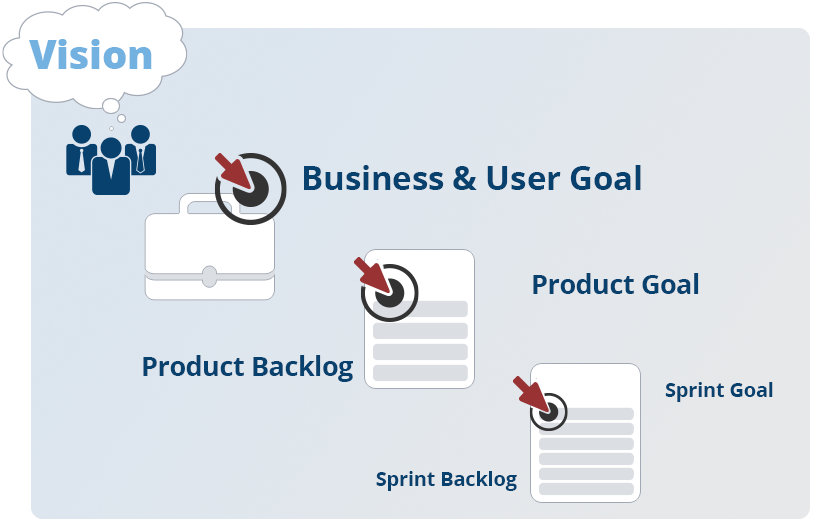The Product Goal. One Goal for the Entire Team
What is a Product Goal according to Scrum? How is it developed? What purpose does it have?

The Product Vision serves as the orientation of the team and the common focus on a goal. It can also be a "moonshot", i.e. an extremely ambitious goal, such as landing on the moon.
Business Goals are business objectives that a company wants to achieve within a certain period of time. They do not have to be specific or have clearly defined actions. They are formulated as value-creating outcomes that the business wants to achieve. User Goals are goals by and for users, that is, descriptions of end states that users want to achieve.
The Product Goal is an overarching goal that you want to achieve with a product. Although it is abstract, it should be derived from KPIs. That means it should be measurable and achievable within a certain period of time.
The Sprint Goal is a goal set for the Sprint that can be achieved by implementing the Product Backlog. Sprint Goals result from negotiations between the Product Owner and the development team. Sprint Goals should be specific and measurable.
Referring to the desired future state of a product that a Scrum team works towards, a Product Goal has come to be known as the defining characteristic of a Product Backlog. In other words, all Product Backlog Items (PBIs) share the same purpose of helping to achieve a Product Goal.
Being a long-term objective, a Product Goal must either be attained or given up on before a Scrum team can move on to another objective.
Dave West, Product Owner and CEO at scrum.org
The Product Goal is something to strive for, and it is measurable when you have attained it.
Characteristics of Product Goals
The Scrum Guide does not prescribe what the details of a Product Goal are, allowing Scrum teams to design the goal in the right way for their context. Nevertheless, there are a few mandatory characteristics:
- A Product Goal is the only prerequisite that a Scrum Team needs to get started and work on its Product Backlog.
- In accordance with the agile nature of Scrum, a Product Goal and Product Backlog are defined in concurrence with each other; a Product Goal drives the development of a Backlog, and the progress made in a Backlog can determine a Goal’s success, failure or need to adjust.
- A Product Goal provides the context and rationale for a project.
- A Product Goal should have the brevity of an elevator pitch when answering: “What’s your Scrum team working on?”
- For every point in time during a project, there needs to be a clear and concise Product Goal for the Backlog.
- A Product Goal can be achieved despite a Product Backlog being incomplete.
- A deeper understanding of a Product Goal can be gained through the results of Sprints.
- The Product Owner is responsible for both developing a Product Goal, and being able to communicate it to others.
- The relationship between a Product Goal and a Product Backlog is analogous to that of a Sprint Goal and Sprint Backlog.
A Product Strategy or Product Roadmap can provide a directional plan for the realization of a Product Goal.

I find, however, that a product goal is best used to describe a specific and measurable benefit or outcome a product should create in the course of the next two to six months. A sample goal might be to acquire users, increase conversion, generate revenue, or reduce technical debt. Such a goal aligns the stakeholders and development teams, and it directs their work.
What’s more, I like to ensure that product goals are connected to the product strategy and its user and business goals. This helps me choose the right product goals and it ensures that meeting a product goal is a step towards creating the desired value for the users and the business.
From: Product Goals in Scrum
Roman Pichler
How to Define Product Goals
Product Goals are measurable stepping stones designed to push the threshold of knowledge towards our Product Vision.
Chris Lukassen, The Product Samurai
Product Goals provide a means of orientating towards the overarching direction of a Product Vision. Goals also join the work that takes place at lower levels of abstraction in a project, such as user stories, with the highest level of a project’s abstraction: the Product Vision. In addition, the achievement of a Product Goal contributes to the fulfilment of a Product Vision. A Product Goal is defined by the team that works towards it and will be stated clearly in the Product Backlog. Goals are not determined according to the work itself, rather by the requirements of the market, which themselves are influences on the latter. Plausibility and achievability are also necessary components when determining goals, and every PBI must work be working in the same direction towards the same goal. As already mentioned, Product Goals can change, and this is a natural part of Scrum methodology. Adjustments are made by the Scrum team according to whatever the novel circumstances demand. The overall development and communication of a product goal, however, remains the purview of the Product Owner.
Vision
The desired future state achieved through the application of a developed system
Example: Become the leading online provider of baked goods in the UK.
User & Business Goals
The value proposition of the product and the desired business benefit
Example: Deliver products free of charge and grow customer base.
Product Goal
The future state of a product, its intended use, or its desired benefit
Example: Have a website that provides a delivery service of baked goods to a major city, e.g. London.
Sprint Goal
The purpose of a Sprint
Example: Build the basic outline of a website where customers can order baked goods.
Product Goals are mostly written in a way that implies that multiple Sprints are needed to realize them. When a Sprint is over, a review is compiled that documents the progress made in that respective Sprint. A Product Goal can be realized without all PBIs having been completed. Once a Product Goal has been achieved, a Scrum team should move on to another objective. In its essence, a Product Goal is a simple guiding statement that provides a Scrum Team and Stakeholders of a project with a common context and purpose.
Scrum Guide 2020
